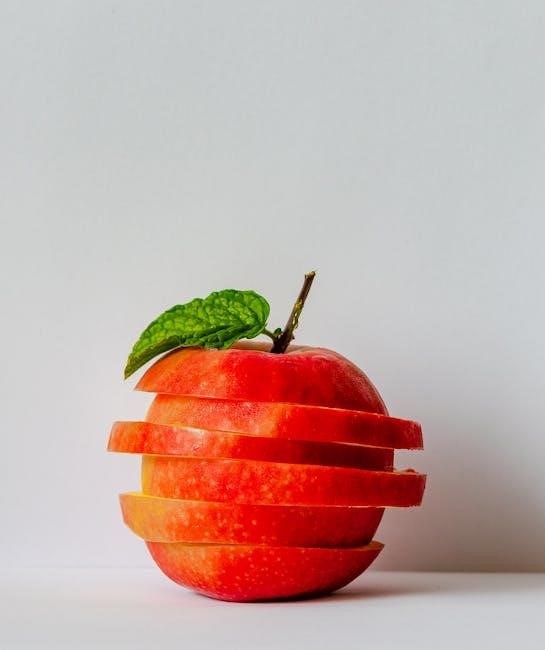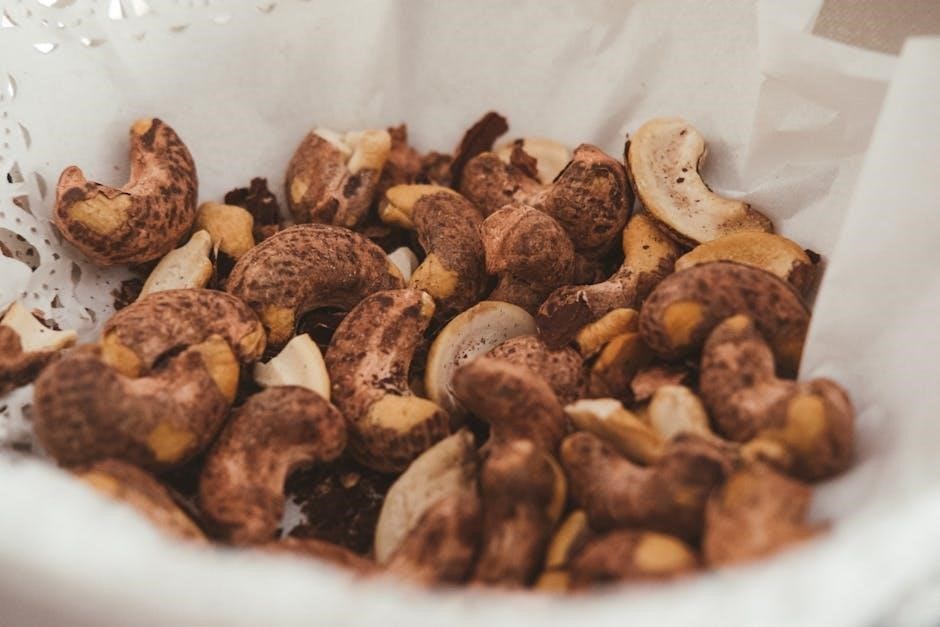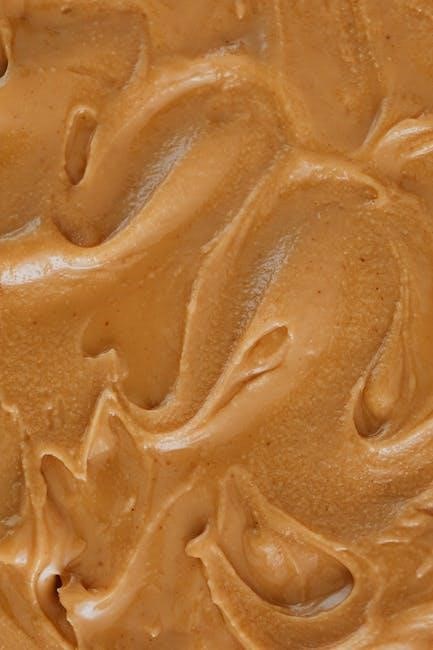
Gastric ulcers are sores in the stomach lining, causing pain, bloating, and nausea. A well-balanced diet plays a key role in managing symptoms and promoting healing.
1.1 Definition and Types of Gastric Ulcers
Gastric ulcers are open sores in the stomach lining, causing pain and discomfort. They are part of peptic ulcers, which also include duodenal ulcers in the small intestine. Gastric ulcers occur when stomach acid damages the protective mucous layer. Types include acute and chronic ulcers, with chronic often linked to Helicobacter pylori infection or long-term NSAID use. Understanding the type and cause is crucial for effective management and dietary adjustments to promote healing and prevent recurrence.
1.2 Prevalence and Risk Factors
Gastric ulcers affect millions worldwide, with higher prevalence in individuals over 60. Key risk factors include Helicobacter pylori infection, NSAID use, and smoking. Poor diet, stress, and excessive alcohol consumption also contribute. A diet high in salt and low in fiber can increase stomach acid production, worsening symptoms. Understanding these factors helps tailor dietary and lifestyle changes to manage and prevent ulcers effectively.
1.3 Common Symptoms of Gastric Ulcers
The most common symptom of gastric ulcers is a dull, burning stomach pain, often worsening on an empty stomach. Other symptoms include bloating, burping, nausea, vomiting, and weight loss. Some individuals may experience poor appetite or discomfort that subsides after eating. In severe cases, bleeding ulcers can lead to black stools or vomit. If symptoms persist or worsen, seeking medical attention is crucial to prevent complications and ensure proper treatment. Early diagnosis and dietary adjustments can significantly improve outcomes.

Role of Diet in Gastric Ulcer Management
Diet plays a crucial role in managing gastric ulcers by reducing symptoms and promoting healing. It helps avoid foods that trigger acid production and stomach irritation.
2.1 Importance of Dietary Changes
Dietary changes are essential for managing gastric ulcers, as they help reduce symptoms and prevent further irritation. A bland diet avoids foods that trigger acid production, such as spicy or fatty items. Eating smaller, more frequent meals can ease digestion and minimize discomfort. Avoiding alcohol and NSAIDs is also crucial, as these can worsen symptoms. A well-planned diet not only aids in healing but also prevents complications. Consulting a registered dietitian ensures personalized advice tailored to individual needs, promoting optimal recovery and long-term health.
2.2 How Diet Affects Stomach Acid Production
Diet significantly influences stomach acid production, with certain foods triggering increased secretion. Spicy, fatty, and acidic foods can stimulate acid production, worsening ulcer symptoms. In contrast, non-acidic foods like lean proteins and whole grains help reduce irritation. Avoiding caffeine and alcohol, which also stimulate acid, is crucial. A balanced diet focuses on minimizing acid triggers, promoting a less acidic environment for healing. Monitoring food choices helps manage symptoms and supports the recovery process for individuals with gastric ulcers.
2.3 Overview of a Gastric Ulcer Diet Plan
A gastric ulcer diet plan focuses on reducing symptoms by avoiding irritants and promoting healing. It emphasizes lean proteins, low-acid fruits and vegetables, whole grains, and probiotic-rich foods. Small, frequent meals are recommended to avoid overloading the stomach. Avoiding spicy, fatty, and high-acid foods is crucial, as they can trigger acid production. Staying hydrated and chewing food thoroughly also support digestion. A well-balanced diet helps manage symptoms, prevents complications, and supports overall gut health, aiding in the recovery process for individuals with gastric ulcers.

Foods to Include in a Gastric Ulcer Diet
Incorporate lean proteins, low-acid fruits, and vegetables to reduce irritation. Whole grains and probiotic-rich foods support healing and maintain a healthy stomach lining, aiding recovery.
3.1 Lean Proteins and Their Benefits
Lean proteins like chicken, turkey, and fish are gentle on the stomach and provide essential nutrients for healing; They help maintain muscle strength without triggering acid production, making them a key component of a gastric ulcer diet. Additionally, plant-based options such as tofu and legumes offer protein without the risk of excessive fat or acidity, supporting overall digestive health and recovery.
3.2 Low-Acid Fruits and Vegetables
Low-acid fruits and vegetables are essential for a gastric ulcer diet as they minimize stomach irritation. Options like bananas, melons, and non-citrus fruits are ideal. Vegetables such as cucumbers, squash, and carrots are also recommended; These foods are gentle on the stomach lining, reducing inflammation and discomfort. Incorporating them into meals helps maintain a balanced diet while supporting the healing process and preventing acid buildup.
3.3 Whole Grains and Their Role in Healing
Whole grains are highly recommended in a gastric ulcer diet due to their anti-inflammatory properties and ability to stabilize stomach acid. Oatmeal, brown rice, and quinoa are excellent choices, as they provide essential nutrients like fiber, vitamins, and minerals. These foods help soothe the stomach lining, promoting healing and reducing irritation. Incorporating whole grains into meals supports overall digestive health and aids in managing symptoms effectively.
3.4 Probiotic-Rich Foods for Gut Health
Probiotic-rich foods, such as yogurt, kefir, sauerkraut, and kimchi, play a crucial role in maintaining gut health. These foods contain live cultures that help balance stomach pH and reduce inflammation. Probiotics support the healing of gastric ulcers by enhancing the protective lining of the stomach and preventing harmful bacteria overgrowth. Incorporating these foods into the diet can alleviate symptoms and promote a faster recovery, making them a valuable addition to a gastric ulcer diet plan.

Foods to Avoid in a Gastric Ulcer Diet
Foods that increase stomach acid, such as citrus fruits, tomatoes, chocolate, and spicy dishes, should be avoided to prevent irritation and exacerbate symptoms.
4.1 Foods That Increase Stomach Acid
Certain foods can trigger stomach acid production, worsening gastric ulcer symptoms. These include citrus fruits, tomatoes, chocolate, and spicy dishes. Alcohol, caffeine, and processed meats also stimulate acid secretion, potentially irritating the stomach lining. Avoiding these foods helps reduce acid-related discomfort and supports healing. Incorporating bland, non-irritating foods is essential for managing symptoms effectively and promoting a healthier digestive environment.
4.2 Spicy and Irritating Foods
Spicy and irritating foods can exacerbate gastric ulcer symptoms by irritating the stomach lining and delaying healing. Chili peppers, hot sauces, and acidic foods like vinegar or pickled items should be avoided. These foods can trigger discomfort, bloating, and acid reflux, worsening the condition. Reducing or eliminating these irritants helps create a more conducive environment for healing and reduces symptom severity.
4.3 Processed and High-Fat Foods
Processed and high-fat foods can hinder the healing process of gastric ulcers by causing stomach irritation and delaying recovery. Fried foods, fast food, and processed meats should be avoided as they can trigger acid production and discomfort. Opting for lean proteins and low-fat alternatives helps reduce symptoms and supports a healthier digestive environment. Incorporating these changes aids in managing gastric ulcers effectively.
4.4 Caffeine and Alcohol
Caffeine and alcohol can exacerbate gastric ulcer symptoms by increasing stomach acid production and irritating the stomach lining. Both substances can delay healing and worsen discomfort. Limiting or avoiding these items is crucial for managing ulcers effectively. Even moderate consumption can trigger acid reflux and pain, so it’s advisable to reduce intake or eliminate them entirely. Consulting a healthcare provider can help determine the best approach based on individual sensitivity and overall health.

General Dietary Guidelines

Caffeine and alcohol can irritate the stomach lining, increasing acid production and worsening ulcer symptoms. Reducing or avoiding these substances helps alleviate discomfort and supports healing. Moderation is key, as even small amounts can trigger acid reflux and pain. Eliminating them entirely may be necessary for some individuals to manage symptoms effectively and promote a faster recovery. Consulting a healthcare provider can provide personalized guidance based on specific conditions and sensitivity levels.
5.1 Eating Small, Frequent Meals
Eating small, frequent meals helps manage gastric ulcer symptoms by preventing the stomach from becoming overly full. This approach reduces pressure on the stomach lining and minimizes acid production. Opt for 4-6 smaller meals throughout the day, including snacks, to maintain steady digestion and avoid discomfort. Avoiding large, heavy meals ensures the stomach doesn’t become overloaded, which can exacerbate pain and slow healing. This method also helps maintain balanced acid levels, promoting a more stable gastric environment for recovery.
5.2 Avoiding Long Fasting Periods
Avoiding long periods without food is crucial for managing gastric ulcers. Extended fasting can lead to excessive stomach acid buildup, worsening pain and discomfort. Eating smaller, more frequent meals helps maintain a balanced stomach environment, reducing irritation and promoting healing. This approach prevents overloading the stomach, which can trigger symptoms. By spacing meals evenly, individuals can better control acid production and alleviate discomfort associated with gastric ulcers, supporting overall digestive health and recovery.
5.3 Chewing Food Thoroughly
Chewing food thoroughly is essential for managing gastric ulcers. Proper chewing prevents swallowing air, which can cause discomfort and bloating. It also ensures food is well-digested, reducing the risk of irritation in the stomach lining. By breaking down food completely, the digestive system functions more efficiently, minimizing symptoms like nausea and pain. This simple practice contributes significantly to healing and maintaining a healthy gastric environment, making it a crucial part of a gastric ulcer diet plan.
5.4 Staying Hydrated
Staying hydrated is crucial for overall health and gastric ulcer management. Drinking water helps maintain stomach pH balance and prevents acid buildup. Aim for 8-10 glasses of water daily, avoid caffeinated or carbonated beverages that may irritate the stomach lining. Herbal teas and non-acidic fruit juices can also contribute to hydration. Proper hydration aids digestion and reduces symptoms like bloating and discomfort, promoting a faster recovery and healthier digestive system.

Lifestyle Modifications
Adopting healthy lifestyle changes can significantly aid in managing gastric ulcers. Quitting smoking, limiting alcohol, and avoiding NSAIDs reduce stomach irritation. Regular physical activity and stress management also promote healing and overall well-being.
6.1 Quitting Smoking
Quitting smoking is essential for managing gastric ulcers, as smoking reduces stomach acid regulation and blood flow to the stomach lining, slowing healing. It increases the risk of complications like gastric cancer. Nicotine also stimulates acid production, worsening symptoms. To quit, consider nicotine replacement therapies or counseling. Consulting a healthcare provider can provide tailored strategies to overcome addiction. Quitting smoking not only aids ulcer recovery but also improves overall health, reducing inflammation and promoting a healthier digestive system.
6.2 Avoiding NSAIDs
Nonsteroidal anti-inflammatory drugs (NSAIDs), such as ibuprofen and aspirin, can irritate the stomach lining, worsening gastric ulcers. Long-term use can impede healing and increase the risk of complications. Patients with gastric ulcers should avoid NSAIDs unless prescribed by a doctor.
Instead, acetaminophen is often recommended for pain relief. Always consult a healthcare provider before stopping or starting medications to ensure proper management of symptoms and prevent further damage to the stomach lining.
6.3 Managing Stress
Stress can increase stomach acid production, worsening gastric ulcer symptoms. Techniques like deep breathing, yoga, and meditation help reduce stress levels and alleviate discomfort.
Incorporating these practices into daily routines can promote healing and improve overall well-being. Consulting a healthcare provider for additional stress-management strategies is also beneficial.
6.4 Regular Physical Activity
Regular physical activity promotes overall health and can help manage gastric ulcer symptoms. Gentle exercises like walking or yoga improve digestion and reduce stress, which can exacerbate symptoms.
Avoid intense workouts that may cause stomach discomfort. Engaging in moderate activity aids in maintaining a healthy weight and enhances the body’s healing processes, benefiting those with gastric ulcers.

Sample Meal Plan for Gastric Ulcer Diet
A well-structured meal plan helps manage symptoms and promote healing. Breakfast: oatmeal with banana and herbal tea. Lunch: grilled chicken with steamed vegetables. Dinner: fish with quinoa.
7.1 Breakfast Options
Start your day with gentle, stomach-friendly foods. Oatmeal with a banana and a splash of low-fat milk is an excellent choice, providing fiber and soothing the stomach lining. Scrambled eggs or egg whites are also ideal, as they are low in acid and easy to digest. Herbal teas, like chamomile or peppermint, can aid digestion and reduce inflammation. Avoid citrus fruits and caffeine, which can trigger acid production. Opt for whole grain cereals or toast with a small amount of honey for a balanced and comforting breakfast.
7.2 Mid-Morning Snacks
Opt for snacks that are gentle on the stomach and rich in nutrients. Low-fat crackers with a small portion of cheese or a ripe banana are excellent choices, providing sustained energy without irritating the stomach lining. Avoid spicy, fatty, or acidic foods. Instead, consider a handful of almonds or a small serving of yogurt with probiotics to support gut health. These options help maintain balance and prevent excessive stomach acid production between meals.
7.3 Lunch Ideas
For lunch, focus on balanced, easy-to-digest meals that avoid irritating the stomach lining. Opt for lean proteins like grilled chicken or turkey, paired with steamed vegetables such as carrots or green beans. Whole grains like rice or quinoa can be added for fiber. Avoid spicy or fatty foods. A small portion of low-acid fruit, such as apples or pears, can be included for added nutrition. Probiotic-rich foods like yogurt may also help soothe the stomach. Keep portions moderate to prevent discomfort.
7.4 Evening Snacks
Evening snacks should be light and gentle on the stomach. Opt for bland, easily digestible options like whole grain crackers with a small amount of low-fat cheese or a banana. Non-citrus fruits, such as apples or pears, are also suitable. Probiotic-rich foods like plain yogurt can help maintain gut health. Avoid spicy, fatty, or acidic foods that may trigger discomfort. Choose small portions to prevent overeating and ensure a smooth transition to the next meal. Stay hydrated with water or herbal tea to aid digestion.
7.5 Dinner Recommendations
Dinner should be light and balanced, focusing on lean proteins like baked chicken, turkey, or fish. Steamed vegetables such as carrots, spinach, or green beans are ideal. Whole grains like rice, quinoa, or oatmeal provide sustained energy without irritation. Opt for low-acid sauces and avoid spices. Ensure meals are cooked without added fats or oils. Keep portions moderate to prevent discomfort. Avoid citrus fruits or tomatoes in the evening. Finish with a glass of water or herbal tea to aid digestion and maintain hydration.

Monitoring and Adjusting the Diet
Regularly track symptoms and adjust the diet to identify trigger foods. Keeping a food diary helps monitor progress and identify patterns. Consulting a dietitian ensures personalized adjustments for optimal healing and symptom relief.
8.1 Tracking Symptoms
Tracking symptoms is crucial for managing gastric ulcers. Keep a daily log of pain levels, bloating, and nausea to identify triggers. Note improvements or flare-ups after meals to refine dietary choices. This data helps pinpoint which foods aggravate symptoms, enabling tailored adjustments. Over time, consistent monitoring ensures the diet remains effective and promotes healing. Regular reviews of the symptom log with a healthcare provider can further optimize treatment plans and improve quality of life for individuals with gastric ulcers.
8.2 Keeping a Food Diary
Keeping a food diary is essential for managing gastric ulcers. Record all meals, snacks, and beverages consumed, noting portion sizes and preparation methods. Also, document any symptoms experienced within 24 hours of eating. This helps identify trigger foods and monitor dietary adherence. Regularly reviewing the diary can reveal patterns, ensuring a balanced and ulcer-friendly diet. Sharing this information with a healthcare provider or dietitian allows for personalized adjustments, optimizing symptom relief and promoting healing. It also ensures nutritional needs are consistently met.
8.3 Consulting a Registered Dietitian
A registered dietitian specializes in creating personalized diet plans tailored to gastric ulcer management. They help identify trigger foods, ensure nutritional needs are met, and prevent deficiencies. By analyzing food diaries and symptoms, dietitians provide customized recommendations, promoting healing and overall gut health. Regular consultations ensure long-term adherence to a balanced diet, addressing specific concerns and adjusting plans as needed. Their expertise is invaluable for optimizing dietary strategies and enhancing quality of life for individuals with gastric ulcers.

The Importance of a Balanced Diet
A balanced diet reduces symptoms, prevents complications, supports healing, avoids irritants, ensures proper nutrition, and promotes overall health for individuals with gastric ulcers.
9.1 Ensuring Nutritional Needs Are Met
A balanced diet ensures adequate intake of essential nutrients, including vitamins, minerals, and proteins, crucial for healing and overall health. Incorporating lean proteins, whole grains, and low-acid fruits and vegetables supports the body’s recovery process while avoiding irritants. Proper nutrition helps maintain energy levels and strengthens the immune system, reducing the risk of complications. Consulting a dietitian can help tailor meals to meet individual needs effectively, ensuring optimal recovery from gastric ulcers.
9.2 Avoiding Nutritional Deficiencies
Avoiding nutritional deficiencies is crucial for healing and overall well-being. A diet rich in whole grains, lean proteins, and low-acid fruits and vegetables ensures adequate intake of essential nutrients like iron, B vitamins, and fiber. Deficiencies in these nutrients can lead to weakened immunity and impaired healing. Including fortified foods and consulting a dietitian can help prevent gaps in nutrition, ensuring the body receives all necessary components for recovery and maintaining optimal health during gastric ulcer management.
9.3 Promoting Overall Health
A balanced diet for gastric ulcers not only aids in healing but also promotes overall health. It emphasizes fruits, vegetables, whole grains, lean proteins, and probiotics, which boost immunity and improve digestion. Healthy fats and antioxidants reduce inflammation, while fiber-rich foods support gut health. This dietary approach helps prevent chronic diseases, such as heart disease and diabetes, ensuring long-term well-being. By focusing on nutrient-dense meals, individuals can manage their condition effectively while enhancing their overall quality of life and energy levels.
A well-balanced diet and lifestyle changes are essential for managing gastric ulcers, promoting healing, and preventing recurrence, ensuring overall health and well-being for individuals with this condition.
10.1 Summary of Key Points
A gastric ulcer diet focuses on balanced nutrition to alleviate symptoms and promote healing. Key points include avoiding acid-triggering foods, incorporating lean proteins, low-acid fruits, whole grains, and probiotics. Lifestyle changes like quitting smoking, limiting NSAIDs, and managing stress are crucial. Regular meals, proper chewing, and hydration support recovery. Monitoring symptoms and consulting a dietitian ensures personalized adjustments. A well-balanced diet not only aids in healing but also prevents recurrence, contributing to overall health and well-being for individuals with gastric ulcers.
10.2 Encouraging Long-Term Adherence
Long-term adherence to a gastric ulcer diet requires commitment and practical strategies. Personalized meal plans, gradual dietary changes, and regular guidance from healthcare professionals can enhance sustainability. Setting realistic goals and celebrating small milestones helps maintain motivation. Patients should focus on flavors and variety to keep meals enjoyable, while tracking progress and staying informed about their condition reinforces the importance of adherence. A supportive environment and consistent routine also play key roles in fostering long-term compliance and overall well-being.